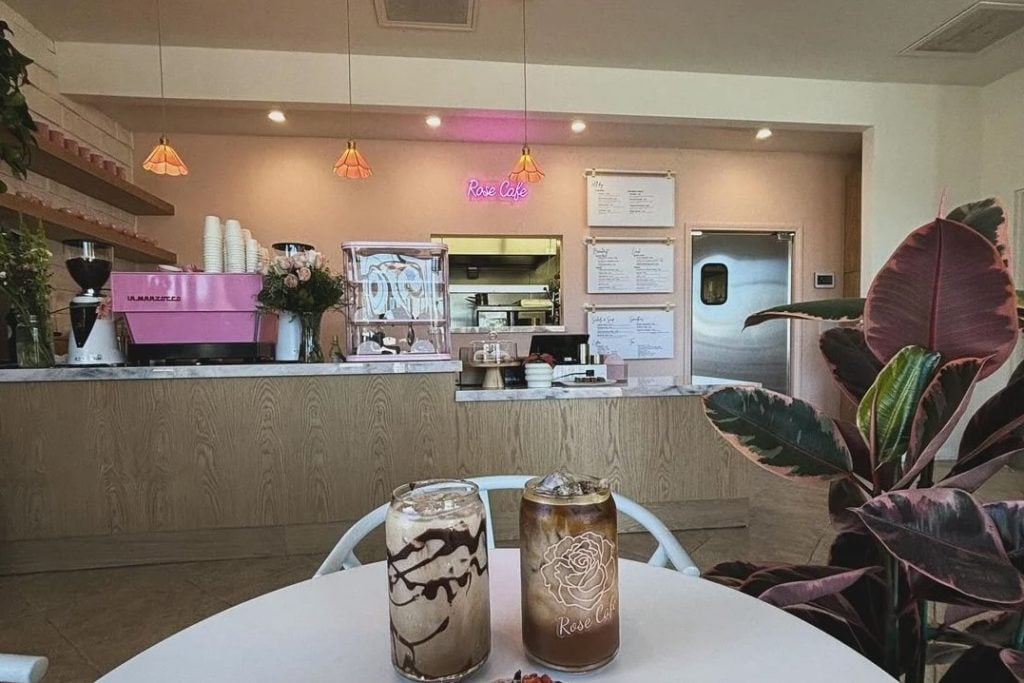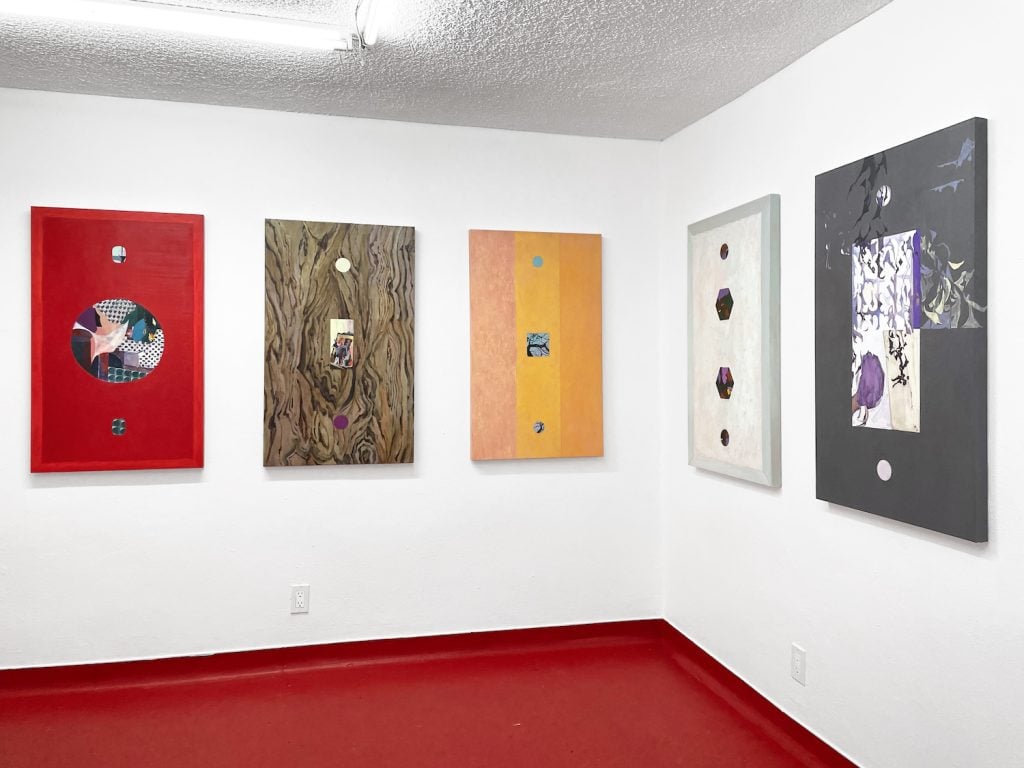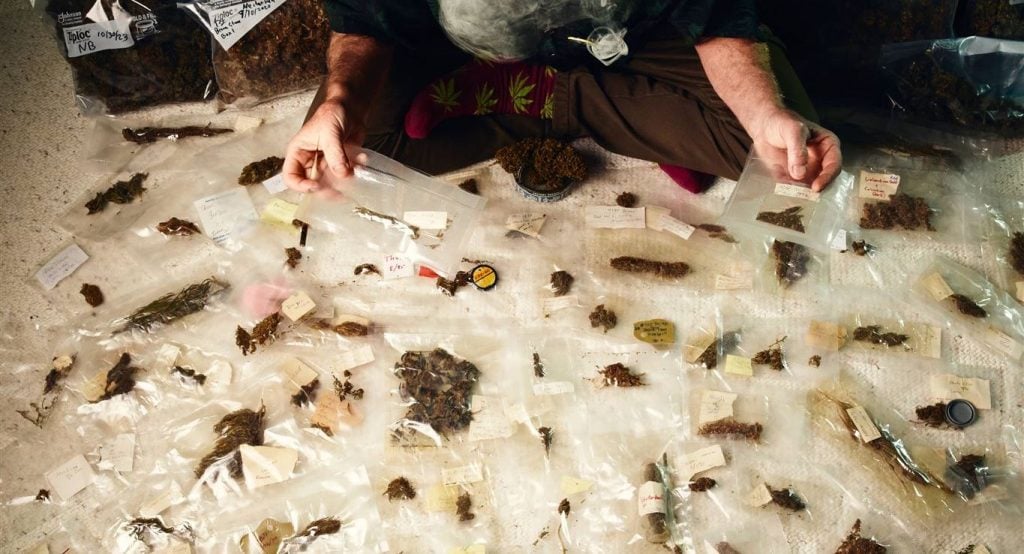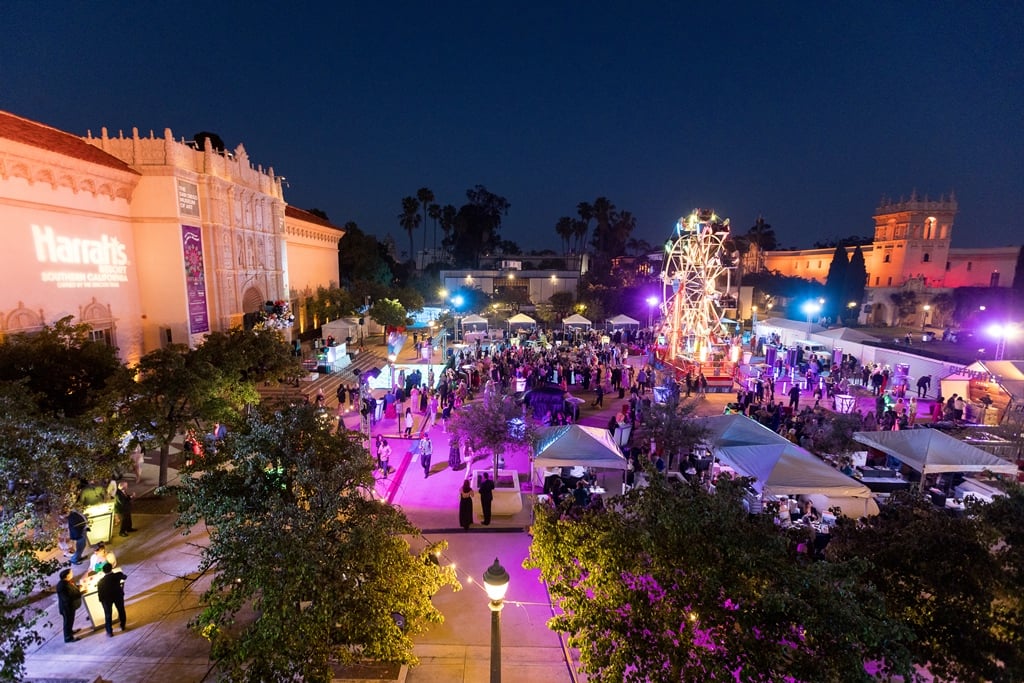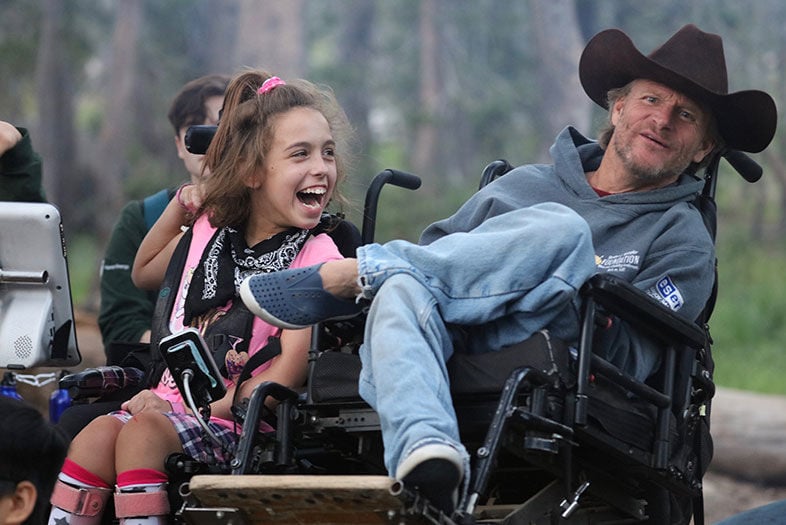In 2010, Coronado resident Stephen J. Wampler made headlines when he scaled El Capitan, the famous granite cliff face in Yosemite National Park. Many rock climbers consider completing its challenging 3,000-foot vertical ascent their crowning achievement—and Stephen is no ordinary climber.
He’s a man who has used a wheelchair his entire life due to cerebral palsy. Though the disorder is caused by a neurological injury before or during birth, it doesn’t affect the mind. Rather, it impairs the brain’s ability to coordinate movement, which we rely on to do things like put one foot in front of the other, or pick up a glass to take a drink. Depending on the severity, one person with CP may be able to walk with a brace or crutches, while another may be unable to walk, speak, or swallow food. A person growing up with CP might work with occupational therapists, hoping to develop a handful of basic life skills most of us take for granted. Scaling a cliff face would not be considered one of them.
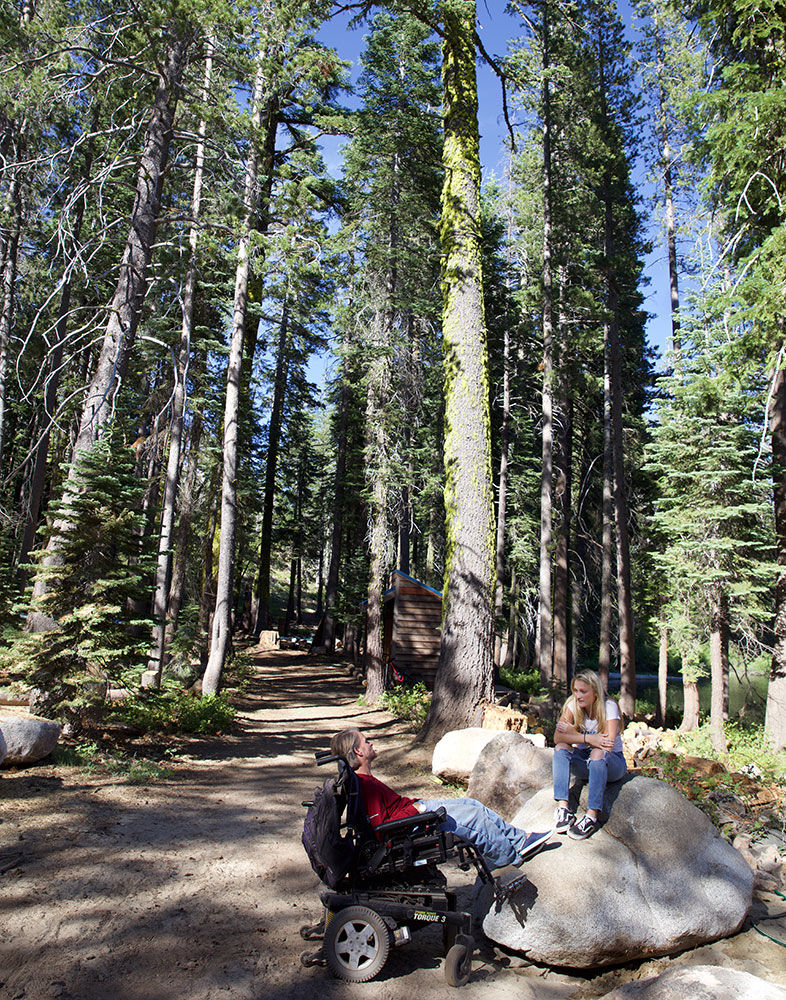
Welcome to Camp Wamp
Stephen and his daughter Charlotte relax in the woods
All the same, at 41 years of age, Stephen conquered El Cap. He strapped into a custom-built support rig, sort of like an action sports lawn chair, and used a handlebar grip to hoist it and himself up a sequence of lead ropes set by his climbing partners. Each pull would lift him two, maybe six inches. Stephen trained a year and a half for this, at a Coronado gym, to the tune of 3,000 pull-ups a day. It would take more than 20,000 to reach the top, a six-day effort requiring him to overcome not just the movement problems of CP, but fatigue, dehydration, and escalating fear as the ground below him grew farther and farther away.
When asked what he remembers about the experience, he says, “Sheer terror. But also sheer euphoria. There are a million different things going through your head.”
I’m with Stephen up in the High Sierras, on a weathered forest path outside Tahoe. It’s late July and we’re within view of another popular California climbing destination, Devils Peak, but he’s not here for that. El Capitan was his first and last climb. He’s here for Camp Wamp, the summer camp he founded in 2002 to give children with disabilities a chance to experience the outdoors. He undertook the hardships of that 3,000-foot climb to raise awareness and funds for the Stephen J. Wampler Foundation, the nonprofit he established to support the camp.
Sleeping Under the Stars
Held annually in five weeklong sessions, Camp Wamp is meant to offer the prototypical summer camp experience: a bucolic lakeside setting, arts and crafts, canoeing. Kids age 10 to 19 make tie dye T-shirts and gather around the campfire to eat s’mores and sing the camp song. With the exception of one hiking trail, all of Camp Wamp’s activities are wheelchair accessible, but in some ways it’s more adventurous than most youth camp experiences. The kids here don’t bunk in cabins, but on cots, sleeping under the stars every night on the shores of nine-acre Deer Lake.
This unsheltered approach is part of the plan. Stephen attended a similar camp here as a child, and he credits the experience with emboldening him to push against the limits of his disability. “It taught me I could do anything I put my mind to,” he says. “Being put into situations I hadn’t been in before, it made me learn faster.”
For example, a scourge of mosquitoes appears early in the first weekly session of this year’s camp. Stephen’s wife, Elizabeth, who co-runs the foundation, wonders whether they should put up mosquito netting. Stephen is quick to veto the idea. “What is a kid going to do in the middle of the night if he has an itch?” he asks her. For a kid with CP who has difficulty with fine motor skills, it’s not always as simple as reaching out to scratch it. “If he can’t get to it himself, he will have to push himself,” Stephen explains. “He will have to figure out a way to communicate that he has a need. And that brings about growth.”
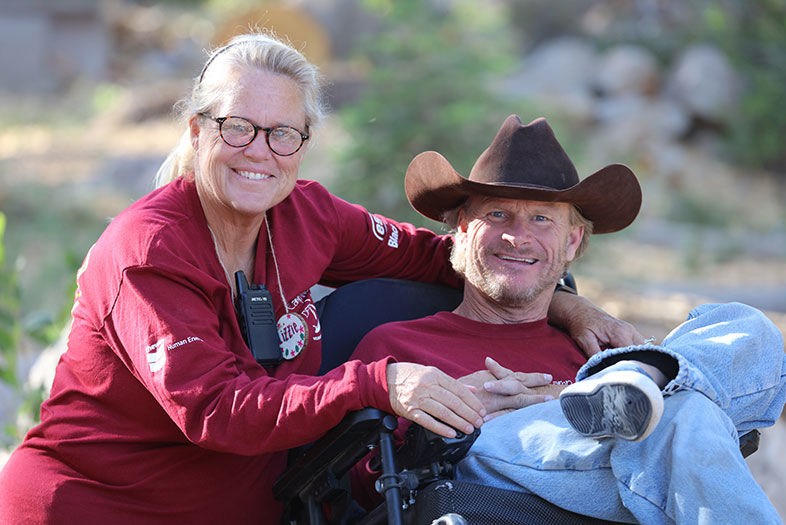
Welcome to Camp Wamp
Elizabeth and Stephen Wampler
But getting campers (or Wampers, as they call themselves) out of their comfort zones doesn’t mean abandoning them to the bears, of course. They’re still well cared for: Camp Wamp pledges a counselor-camper ratio of at least one to one, meaning each kid has their own assigned counselor to ensure any needs are met. There’s nursing staff, certified lifeguards, a covered dining hall, and camp staff, volunteers, and counselors in training on hand. Most of Camp Wamp is outdoors and out of cell phone range, but it has electricity and indoor plumbing. It’s better situated than the wilderness camp Stephen attended, which didn’t even have phone lines.
“This place is the Four Seasons compared to the camp I went to growing up!” he grouches, every bit the stereotypical dad. He and Elizabeth have raised two children together in Coronado, a pair of able-bodied, sun-bleached San Diego blondes—both in college now. Truth is, Stephen’s accomplished a number of things society doesn’t expect from people with cerebral palsy, things that many people with CP might not expect for themselves. He earned a degree from UC Davis and moved from his parents’ Northern California home to take a job in San Diego as an environmental engineer. He’s even given a TED Talk. It’s when the summer camp he grew up attending shut down that Stephen decided his next challenge would be ensuring the next generation of kids with CP would have a chance to test their own limits.
Kids like Bryson Lawrence, a bright 10-(“and a half!”)-year-old who arrived determined to catch his first trout, and did so. Or Austin Klinefelter, a 19-year-old attending for the eighth year, who enjoys swimming in the lake with a flotation device that keeps his head above water, and now regularly swims in pools back home. Or Briana, a 13-year-old returning this year without her wheelchair, who performs a dance routine to Beyoncé in the camp talent show.
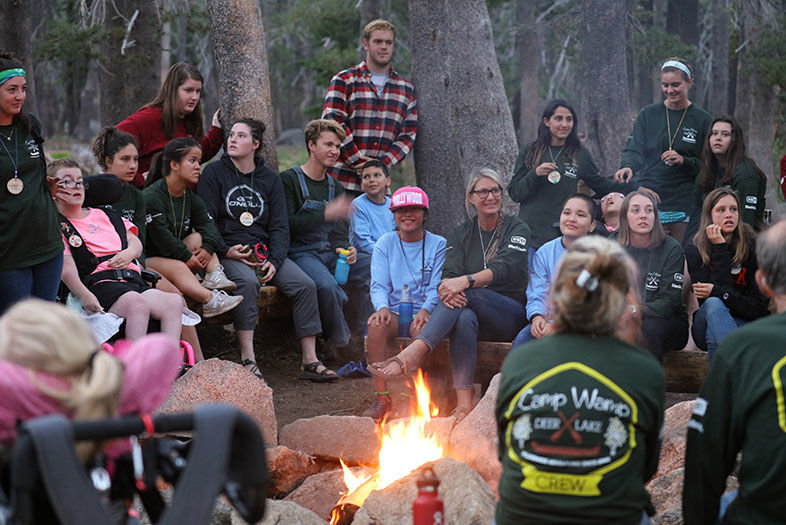
Welcome to Camp Wamp
Everyone gathers around the fire pit
I pull up a seat at the camp’s unofficial hub—the arts and crafts table—and chat with Kacy Stoner. A slender 14-year-old from San Marcos, Kacy has long, blond hair and glasses. She gets around in a wheelchair and speaks slowly, the softness of her voice belying the care she puts into forming each word. “I love it,” she says. “This camp has helped me find who I really am inside.” She’s already looking forward to returning next summer.
Kacy earned cheers from her fellow Wampers by successfully scaling the 30-foot rock climbing wall under her own power.
“She had an athletic achievement,” Elizabeth says. “It was life altering!”
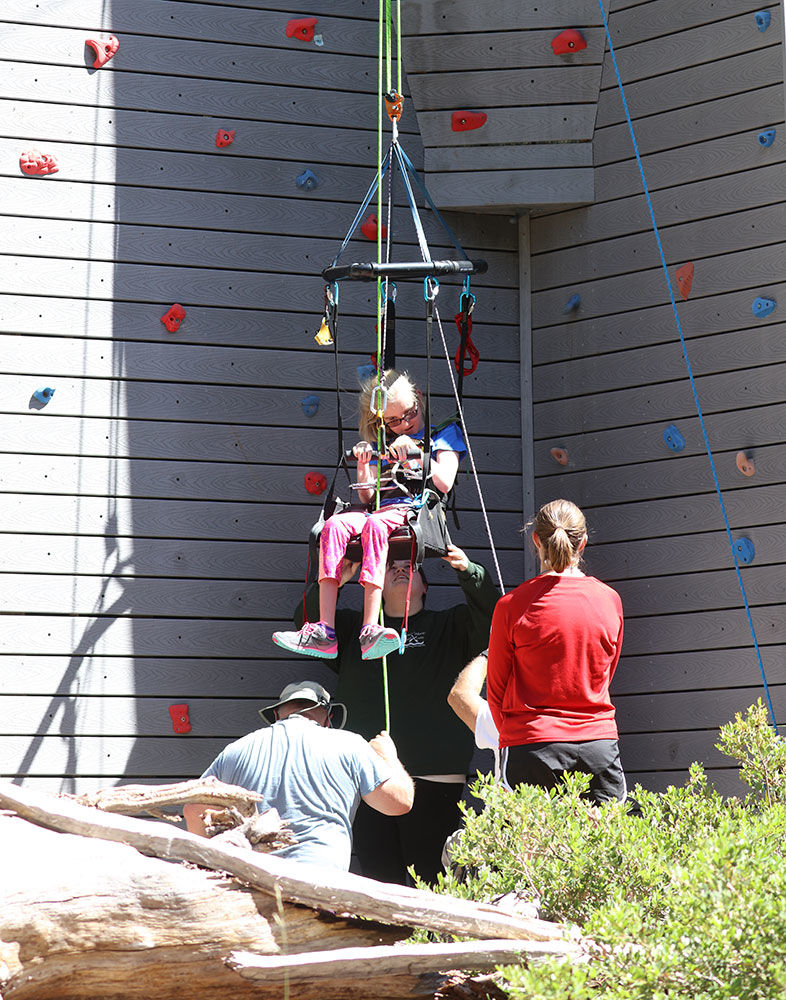
Welcome to Camp Wamp
Kacy Stoner scales a 30-foot rock climbing wall, using a rig similar to Stephen’s when he ascended El Capitan
Learning as They Go
Able-bodied Elizabeth met Stephen at a dinner party in the late ’90s and quickly fell for the determined young man, who wouldn’t let the word “can’t” get in his way.
“I’m not his caregiver,” Elizabeth makes a point of telling people. “I’m his wife.” Her sensitivity comes from a shared life of public misperceptions—some strangers who see them together assume she’s his nurse, because of Stephen’s wheelchair and tremorous limbs. Restaurant servers will sometimes ask Elizabeth for Stephen’s order instead of speaking to him directly.
Such encounters are par for the course for people with a visible disability, adding social anxiety and alienation to the list of challenges they can face. Though to be clear, the social anxiety doesn’t start with the person who has the disability; it starts with the able-bodied folk who forget how to act normally around them.
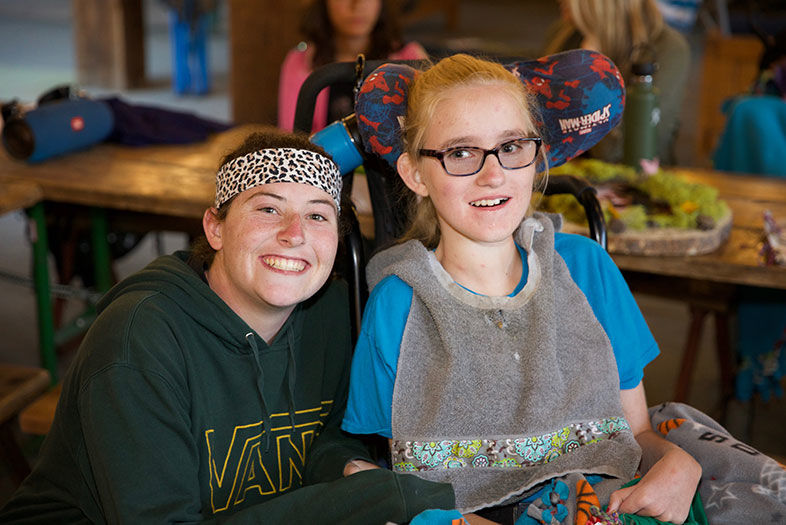
Welcome to Camp Wamp
Camper Kacy Stoner with a camp lifeguard
Kacy says that’s one of the big hurdles to making friends when you have CP. The rudeness of strangers who stare, treat her like a baby, or pretend to understand what she’s saying even if they don’t. When I ask whether her speech impediment scares people away, she claps back: “I’m talking clear. They just don’t know my voice.”
Of course, making friends is the best part of any summer camp, and part of Camp Wamp’s magic is the wholly inclusive environment it creates. The Wampers form lasting friendships not only with one another, but with their counselors and junior counselors as well.
Most of the counselors are college age and working summer jobs. Some are pursuing nursing or therapeutic degrees, but only a few of them showed up having known someone with a disability, meaning they had to learn to overcome those social hurdles on the job.
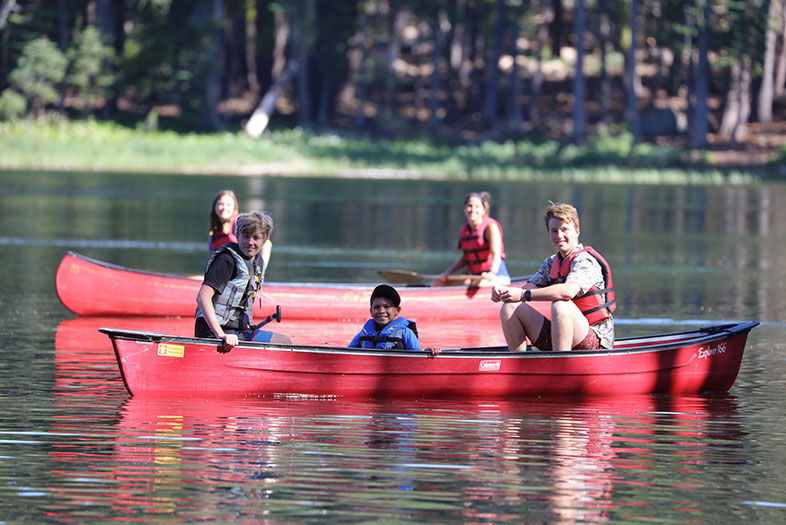
Welcome to Camp Wamp
Camper Bryson Lawrence (middle) smiles from a canoe, paddled with help from his counselor, Jonathan Mehki (right)
One of the many endearing counselor-camper duos is Jonathan Mehki, a recent Coronado High graduate, and Bryson, the aforementioned trout fisherman.
Jon admits he was nervous about counseling a kid with special needs. He still is. He was concerned about disappointing his camper, who walks with the help of trekking poles. Instead the two bonded, and Bryson has had a fantastic experience, sleeping under the stars for the first time, and breezily keeping up with his older friend’s wit. All Jon had to do was be himself, and maybe walk a little slower than usual.
“Bryson has his wheelchair and his walker here,” Jon says. “Didn’t use them once.”
Other relationships are more difficult to spot. Sarah Karp, a nursing student at San Diego State University and first-year Camp Wamp counselor, has been paired with a younger camper, Annie, who is unable to speak. Sarah too admits to being scared at first—mainly of boring someone who couldn’t speak up to change the topic—until she got a sense of Annie’s personality.
“It’s been really fun to find ways to communicate with her,” Sarah says.
Although not all of them speak, every Wamper can at least communicate with gestures or eye movements to answer yes or no. “They have a lot on their mind they want to say, and it’s nice to be able to give them a chance to express themselves,” Sarah says. Annie does find ways to express herself; by the end of the week, she’s using their hard-earned communication skills to subtly play pranks on her counselor.
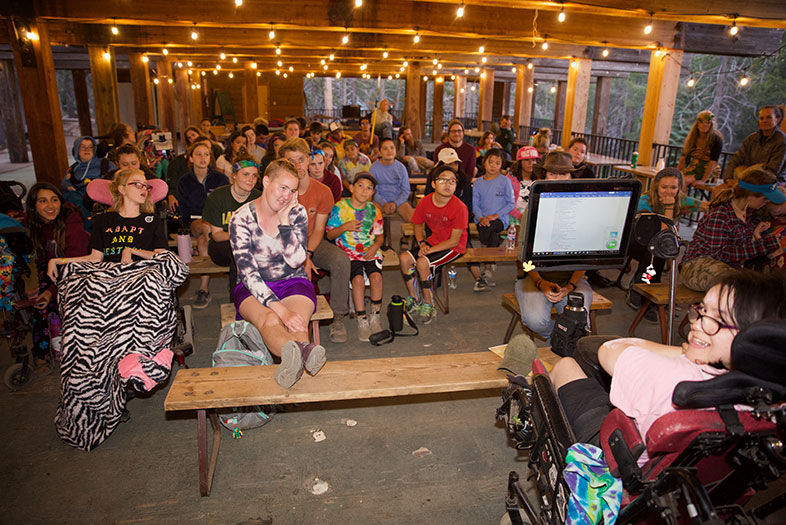
Welcome to Camp Wamp
Caitlin performs her poem “Things I Carry” at the camp talent show
Carrying On
One of my favorite camp moments takes place at the talent show. Though she can neither walk nor speak, 19-year-old Caitlin Greenwell is able to operate a computer with an assistive device that tracks her eye movements. For her talent, she uses her text-to-speech software to recite a poem titled “Things I Carry.”
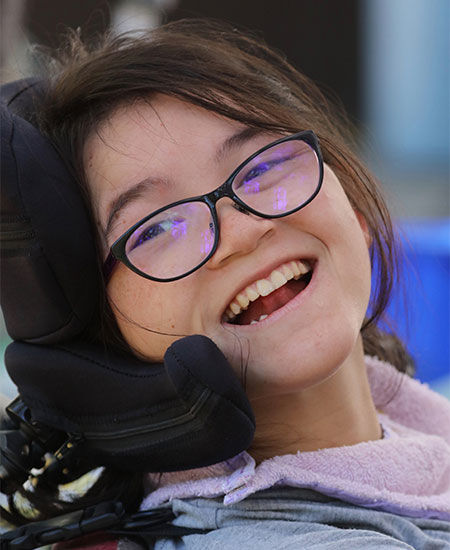
Welcome to Camp Wamp
Camper Caitlin Greenwell
I carry my voice everywhere I go.
It is one of the most important things in my life.
I carry my bag full of important supplies.
I carry cerebral palsy.
It affects my body but it can’t touch my brain.
Caitlin is a Camp Wamp veteran, English major, and aspiring novelist. A later stanza shows more hints of that imagination: I carry my alter ego, Catherina / A bad girl, with emotions and a biker jacket.
Like 2,000 other Wampers over the past 18 years, Caitlin leaves camp brimming with enthusiasm and inspiration. I could say the same about the counselors, counselors in training, lifeguards, nurses, volunteers, and journalists there. As the week winds down and campers return home to their families, most of the tears shed come from the counselors and volunteers. It feels like things have just gotten started, that there are more barriers to break down.
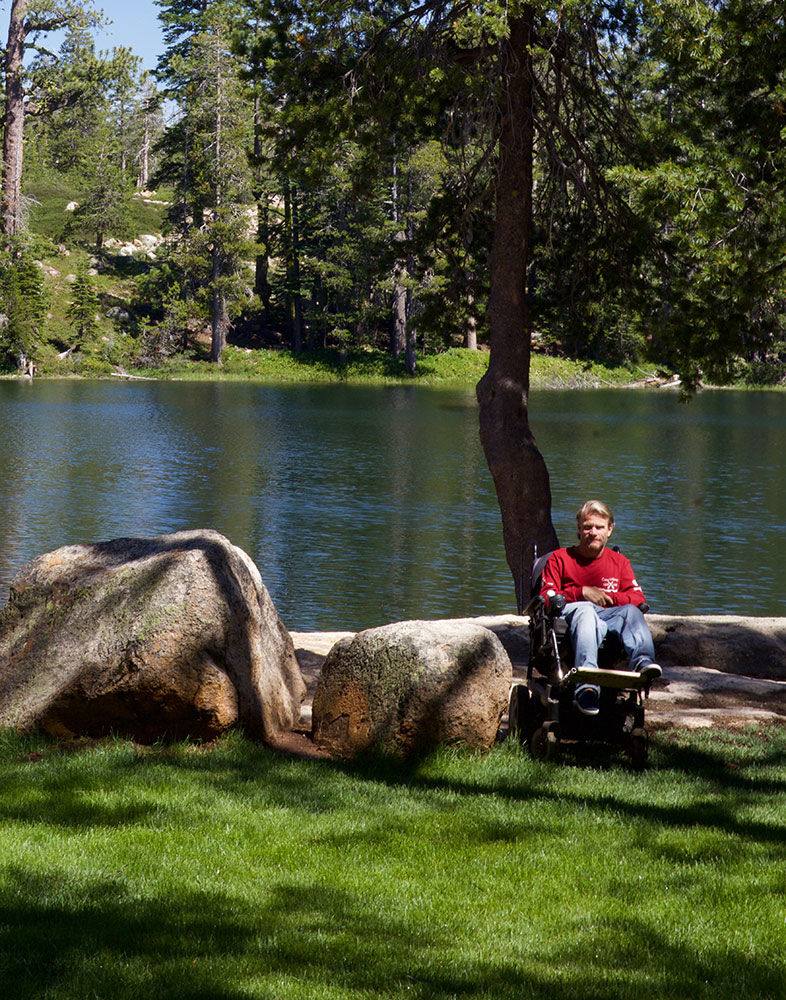
Welcome to Camp Wamp
Stephen by the lake
One day, I find Stephen rolling through the woods with his powerchair reclined, right leg crossed over his left, shaggy blond hair tucked under the brim of a cowboy hat. He projects an air of laid-back confidence, though I know he and the Wampler Foundation have been busy behind the scenes making sure these kids don’t have to worry about anything but what they might look forward to next year.
One of the foundation’s worries, for a number of years, was finding the next location. At first they used leased properties, with no guarantee they could return summer after summer. But Stephen’s mountain-climbing exploits caught the attention of a donor family in Arizona, whose generosity enabled the foundation to secure Camp Wamp a permanent home here, at a 129-acre former Girl Scout camp 20 minutes down a gravel road from a Soda Springs ski resort. Now the foundation’s year-round fundraising efforts can focus on the operating costs associated with hosting campers free of charge, particularly kids who wouldn’t otherwise have the opportunity to spend a night outdoors.
So when I ask Stephen if he still thinks the training and toil of that six-day, 3,000-foot climb was worth it, he says without hesitation, “Yeah. It paid off big time.”
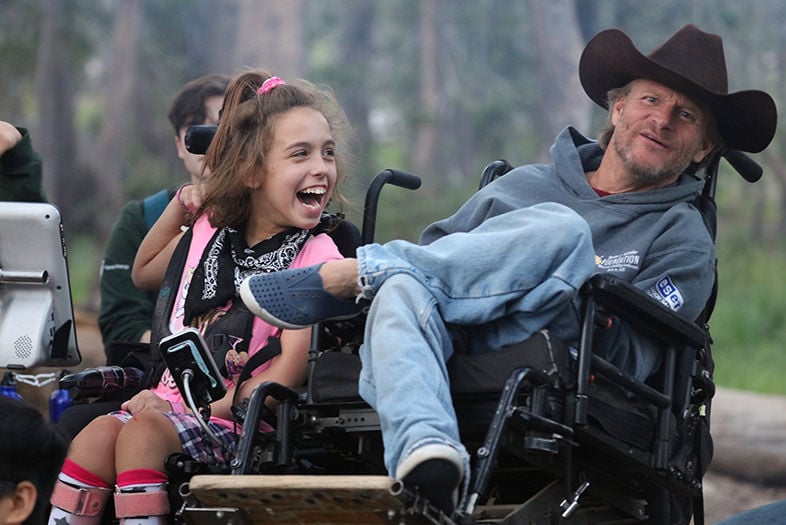
Welcome to Camp Wamp
Stephen Wampler with camper—or “Wamper”—Aurora.

